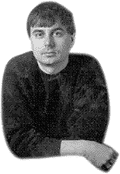Biographical Information
|

I always loved mathematics and in particular geometry and topology.
My next favorite subject is philosophy. I am still curious why we are here.
I have no illusions that we will ever know, but at least I would like to understand
what we are all doing here. Perhaps the evolution of morality as a means
to forge social groups, is a way to get closer to an answer.

My research evolved from algorithms and data structures to
computational geometry and computational topology.
It might sometimes not be obvious, but I use applications
to determine the direction of my research,
keeping in mind that the most applicable of all is a good theory.
A recent interview touches upon this issue:
AATRN interview.

| |
I was born and grew up in Austria.
I visited the United States in 1984 and made an overnight decision to move
there, possibly for a few years.
I accepted the offer from the University of Illinois at Urbana-Champaign
and stayed there until 1999, when I moved to Duke University.
In 2009, I moved to my current position at IST Austria.

My spare time interests include listening to music,
and reading books in mathematics, philosophy, politics, biology, neurobiology,
and on rare occasons a novel.

I co-founded a company in April 1996.
This turned out to be more demanding than I believed although I was warned.
The name simplified from Raindrop Geomagic to Geomagic,
and in 2013, it was bought by 3D Systems, which is a 3D printing company.
|
| I decided to join the new
Institute of Science and Technology in Austria, near Vienna, starting
August 2009. This promises to be challenging and invigorating.
IST Austria is an ambitious acadamic start-up near Vienna.
Under the micro-management of our first president, the
institute grew to about 70 research groups in computer science,
mathematics, biology, neuroscience, physics, chemistry, earth science,
and astronomy. Since January 2023, we have a new president,
and things are lightening up.
|
|

|
Research and Funded Projects
I currently work with visitors:
Janos Pach;
with post-doctoral fellows:
Ranita Biswas, Farid Karimipour,
Hana Kourimska, Morteza Saghafian,
Nicolo Zava;
and with doctoral students:
Sebastiano Cultrera, Ondrej Draganov,
Christopher Fillmore, Teresa Heiss, and
Elizabeth Stephenson.
In 2016, we joined the Sonderforschungsbereich
on discretization in geometry and dynamics,
which is funded in Germany by the DFG and in Austria by the FWF.
The project got extended in 2020 and then again to 2024.
2018 was a good year for me.
I started a project on alpha shape theory extended funded by the ERC,
and I received the Wittgenstein Prize, awarded by the FWF.
In 2019, I started an Austrian-Slovenian cooperation project
with Ziga Virk on algebraic footprints of geometric features
in homology, which is funded by the FWF.
From Fall 2023 to Summer 2024, I will spend my sabbatical working with
Yasuaki Hiraoka and his group at the Kyoto University Institute for Advanced Study.
Publications and Software
I published three books in the general area of computational geometry and topology:
- H. Edelsbrunner and J. Harer. Computational Topology. An Introduction.
Amer. Math. Soc., Providence, Rhode Island, 2010.
link
- H. Edelsbrunner. Geometry and Topology for Mesh Generation.
Cambridge Univ. Press, Cambridge, England, 2001.
link
- H. Edelsbrunner. Algorithms in Combinatorial Geometry.
Springer-Verlag, Heidelberg, Germany, 1987.
link
A complete list of my publications is given in reverse chronological order.
The Alpha Shapes software is designed to analyze point data in three dimensions.
It specializes on molecular conformations, where a molecule is given as a set of atoms
and each atom is a sphere given by its center (a point) and radius.
For surface reconstruction I recommend Geomagic Wrap instead.
I used that software to create the 180 wrapped tubes, which
you can download in .stl format and print if you have a layered technology machine.
Even if you have better things to do, visit a most baffling development
within a Russian-Austrian collaboration:
Hexasphere.
Contact Information
 Email: edels@ist.ac.at Email: edels@ist.ac.at
 Home Page: http://www.ist.ac.at/~edels
Home Page: http://www.ist.ac.at/~edels
 Phone: +43 (2243) 9000-3301 Phone: +43 (2243) 9000-3301
 Fax: +43 (2243) 9000-2007 Fax: +43 (2243) 9000-2007
 Surface mail: Surface mail:
Herbert Edelsbrunner
Am Campus 1
IST Austria
3400 Klosterneuburg
Austria
Last Change: today |

